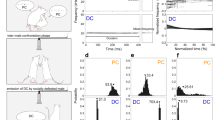Abstract
The effects of cocaine on speech sound discriminations was examined to determine whether cocaine's previously demonstrated effect in reducing speech sound discriminability was dependent upon either the type of stimuli employed (simple tones versus complex speech) or the procedure (stimulus detection versus stimulus discrimination). Because of demonstrated similarities in the way that baboons and humans discriminate speech, and in the way the CNS is thought to encode and process speech sounds in these two species, baboons were trained to perform a choice procedure to identify the occurrence of different synthetic vowel sounds (/a/, /æ/, /ɛ/, /U/, and /љ/). Animals held down a lever and released the lever only when one of four target vowels sounded, and not when a fifth, standard vowel sounded. Acute IM administration of cocaine (0.0032–1.0 mg/kg) produced dose-dependent decreases in vowel discriminability that were mostly due to elevations in false alarms (i.e., releases to the standard vowel) following cocaine. Cocaine also shortened reaction times to the stimuli in two of three baboons, but to a much lesser extent than observed previously. These results suggest that cocaine may interfere with the ability of the CNS to process the acoustic cues in speech sounds, and that the effects of cocaine on reaction times may depend upon the complexity of the reaction time procedure employed.
Similar content being viewed by others
References
Boutros NN, Uretsky N, Berntson G, Bornstein R (1994) Effects of cocaine on sensory inhibition in rats: preliminary data. Biol Psychiatry 36: 242–248
Brady KT, Lydiard RB, Malcolm R, Ballenger JC (1991) Cocaineinduced psychosis. J Clin Psychiatry 52: 509–521
Branch MN, Sizemore GM (1988) Behavioral tolerance to cocaine in squirrel monkeys: acute and chronic effects on complex operant behavior. Pharmacol Biochem Behav 30: 737–748
Davis, M (1985) Cocaine: excitatory effects on sensorimotor reactivity measured with acoustic startle. Psychopharmacology 86: 31–36
Falk JL, Lau CE (1991) Synergism by caffeine and by cocaine of the motor control deficit produced by midazolam. Pharmacol Biochem Behav 39: 525–529
Fischman MW (1984) The behavioral pharmacology of cocaine in humans. Paper presented at Cocaine: pharmacology effects, and treatment of abuse. NIDA Research Monograph, Washington, DC
Foltin RA, Fischman MW (1991) Smoked and intravenous cocaine in humans. J Pharmacol Exp Ther 257:247–261
Grilly DM (1992) Aging changes the effects of cocaine on vigilance task performance of rats. J Gerontol 47: B171–176
Grilly DM, Grogan TW (1990) Cocaine and level of arousal: effects on vigilance task performance of rats. Pharmacol Biochem Behav 35: 269–271
Grilly DM, Nocjar C (1990) Cocaine and vigilance task performance of rats: effects of delay of reinforcement. Pharmacol Biochem Behav 37: 643–648
Herning RI, Jones RT, Hooker WD, Tulunay FC (1985) Information processing components of the auditory event related potential are reduced by cocaine. Psychopharmacology 87: 178–185
Herning RI, Hooker WD, Jones RT (1987) Cocaine effects on electroencephalographic cognitive event-related potentials and performance. Electroencephalogr Clin Neurophysiol 66: 34–42
Hienz RD, Brady JV (1988) The acquisition of vowel discriminations by nonhuman primates. J Acoust Soc Am 84: 186–194
Hienz RD, Brady JV (1989) Diazepam and δ-9-THC: contrasting effects on the discrimination of speech sounds in nonhuman primates. Psychopharmacology 99: 261–269
Hienz RD, Spear DJ, Brady JV, Bowers DA (1993) Effects of cocaine on sensory/motor function in baboons. Pharmacol Biochem Behav 45: 399–408
Hienz RD, Spear DJ, Dowers DA (1994) Effects of cocaine on simple reaction times and sensory thresholds in baboons. J Exp Anal Behav 61: 231–246
Hienz RD, Spear DJ, Pyle DA, Brady JV (1995) Cocaine's effects on speech sound discriminations and reaction times in baboons. Psychopharmacology 122: 147–157
Higgins ST, Bickel WK, Hughes JR, Lynn M, Capeless MA, Fenwick JW (1990) Effects of intranasal cocaine on human learning, performance and physiology. Psychopharmacology 102: 451–458
Katz JL (1990) Effects of drugs on stimulus control of behavior under schedules of reinforcement. In: Barrett JE, Thompson T, Dews PB (eds) Advances in behavioral pharmacology, vol. 7. Lawrence Erlbaum Associates, New Jersey, pp 13–38
Kornetsky C, Esposito RU (1981) Reward and detection thresholds for brain stimulation: dissociative effects of cocaine. Brain Res 209: 496–500
Luce RD (1986) Response times: their role in inferring elementary mental organization. Oxford Psychology Series No. 8, Oxford University Press, New York
Macmillan NA, Creelman CD (1991) Detection theory: a user's guide, 1st edn. Cambridge University Press, New York
Nelson KR, Wasserman EA (1978) Temporal factors influencing the pigeon's successive matching-to-sample performance: sample duration, intertrial interval, and retention interval. J Exp Anal Behav 30: 153–162
Robledo P, Kaneko WM, Ehlers CL (1993) The effects of acute cocaine administration on auditory event-related potentials in rats. Neurosci Lett 160: 4–8
Shivapuja BG, Gu ZP, Saunders SS, Quirk WS (1993) Acute effects of cocaine on cochlear function. Hearing Res 69: 243–250
Siegel RK (1978) Cocaine hallucinations. Am J Psychiatry 135: 309–314
Sinnott JM (1989) Detection and discrimination of synthetic English vowels by Old World monkeys (Cercopithecus, Macaca) and humans. J Acoust Soc Am 86: 557–565
Sinnott JM, Kreiter NA (1991) Differential sensitivity to vowel continua in Old World monkeys (Macaca) and humans. J Acoust Soc Am 89: 2421–2429
Sommers MS, Moody DB, Prosen CA, Stebbins WC (1992) Formant frequency discrimination by Japanese macaques (Macaca fuscata). J Acoust Soc Am 91: 3499–3510
Stillman R, Jones RT, Moore D, Walker J, Welm S (1993) Improved performance 4 hours after cocaine. Psychopharmacology 110: 415–420
Author information
Authors and Affiliations
Rights and permissions
About this article
Cite this article
Hienz, R.D., Zarcone, T.J., Pyle, D.A. et al. Cocaine's effects on speech sound identification and reaction times in baboons. Psychopharmacology 125, 120–128 (1996). https://doi.org/10.1007/BF02249410
Received:
Revised:
Issue Date:
DOI: https://doi.org/10.1007/BF02249410




